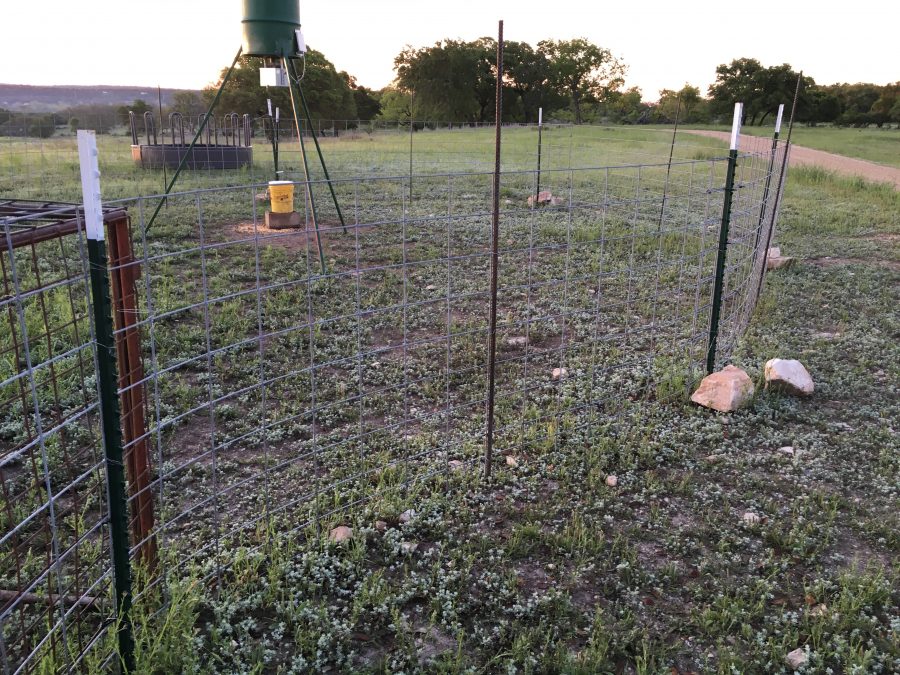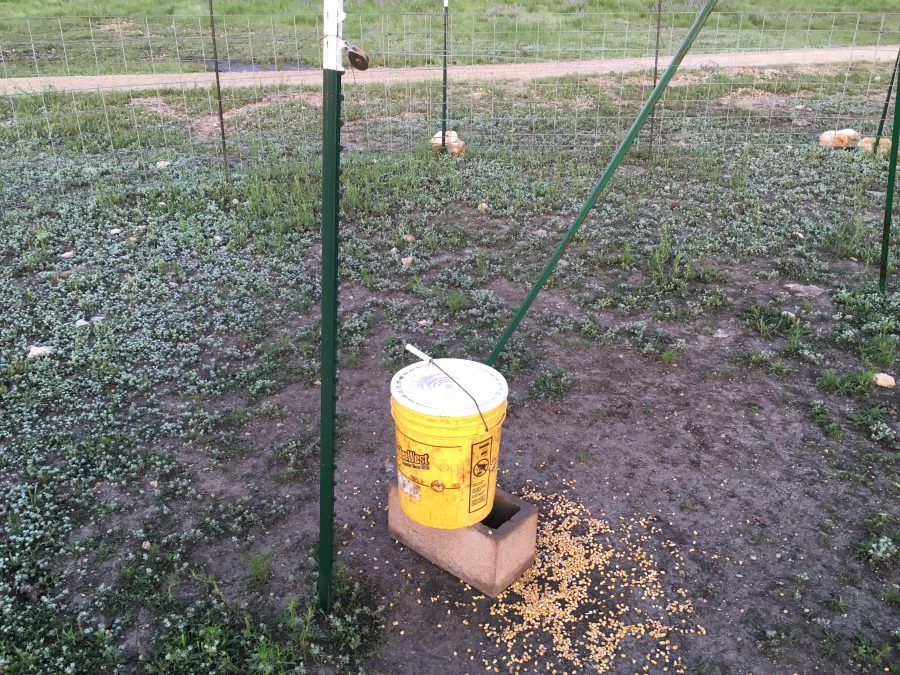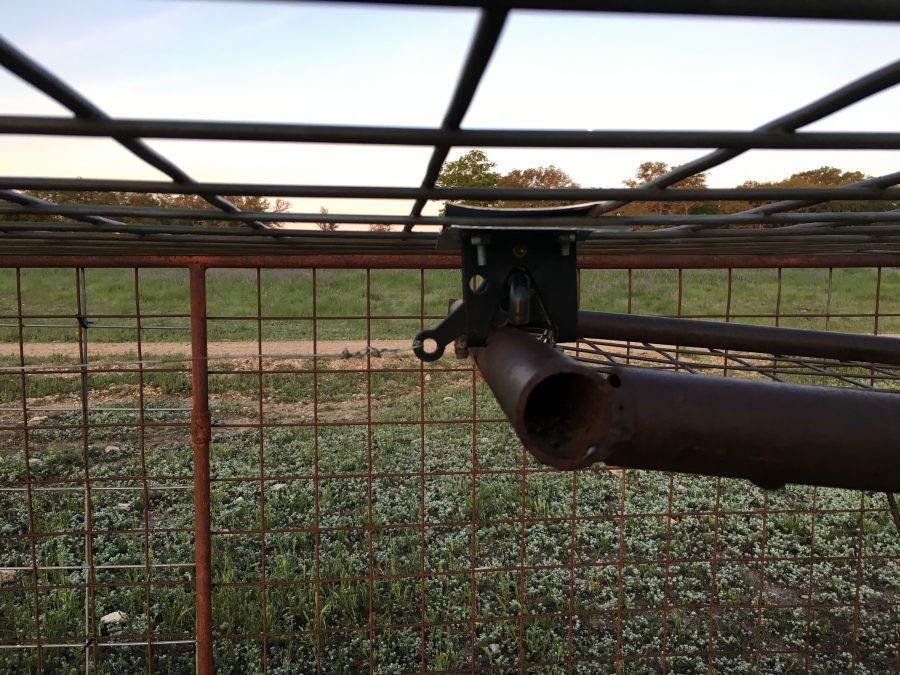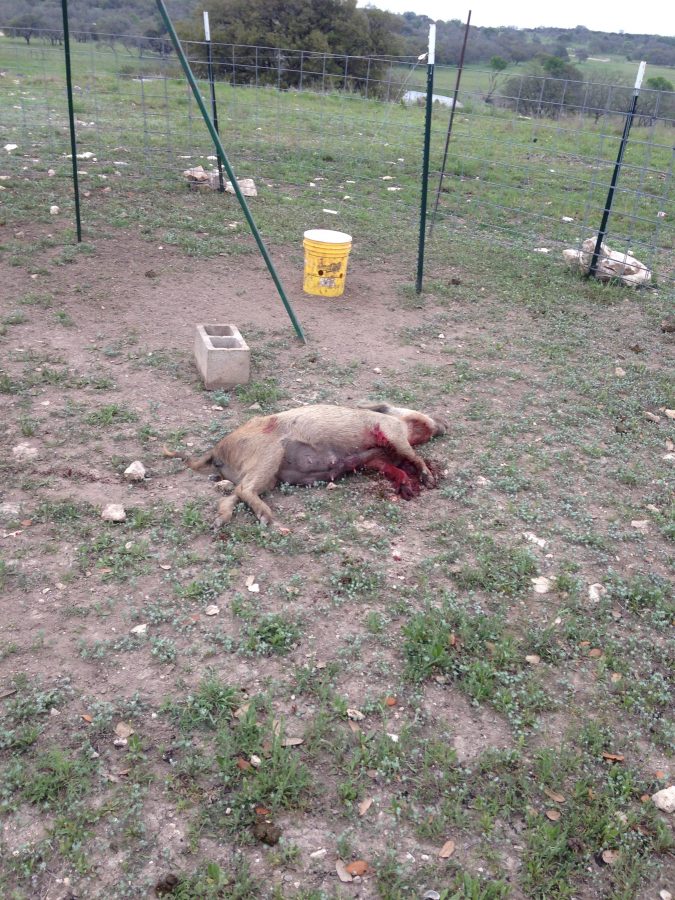
As it relates to the world of guns, the term ‘epidemic’ is thrown around willy nilly. Normally, it follows the phrase “gun violence” and is used by politicians seeking to curtail the rights of law abiding citizens like you and me. Down here in Texas, the word epidemic is more closely associated with the words “feral hog” and describes the widespread outbreak of the porcine problems that our ranchers and farmers face on a daily basis. While using helicopters and thermal night vision gets a lot of attention, the truth is that those methods are woefully inadequate at reducing the number of pigs in the wild. More effective, albeit “boring” methods must be put in place for ranchers, farmers, and landowners looking to thin the herd . . .
To give you a bit of background, I spent my formative years in a fairly rural part of Texas where driving one hundred miles in an evening to take a nice gal to the movies and dinner was considered par for the course. Places like my hometown are where your meat and cheese are grown. In fact, if you ever have the lamb burger at Hopdoddy in Austin, you’ll be eating a burger sourced just a few miles from where I shot my first deer.
My introduction to the depredation caused by the feral hog came by way of a classmate’s dad who flew helicopters for the state on their very first aerial hog eradication program. As a wet behind the ears teenager, I listened in disbelief as he spoke of full days spent killing pigs from the air. Normal culls yielded approximately four thousand pigs over the course of two weeks. Their worst was twenty five hundred pigs in fourteen days. Their best was closer to six thousand. I listened to his stories of hog sorties while feeling far removed from the problem as sightings of feral hogs at our small family place were few and far between.
A decade ago, I left the small town life for the bright lights of the big city to pursue a college degree and the lucrative salary promised by a career in technology. Around the time that I got my feet under me in Austin, I got the opportunity to fly to Columbus, Georgia to go on a night vision hog hunt with the fine folks at JagerPro.
In the video above, JagerPro founder Rod Pinkston delivers a master’s class in hog eradication. Many of the points in the presentation made by Rod were conveyed to me personally when I interviewed him several years ago for my review of his hunting program. The biggest takeaway for me was that their hunting of pigs with fancy night vision gear was the “show” side of his business while trapping and killing en masse was the “go” portion of things. Admittedly, it makes sense. Killing the whole group is the only way to go, and given their prolific breeding schedule, taking out a juvenile female might mean killing off the potential for her to create another fifty or so versions just like her. There’s no doubt that shooting pigs is fun, but if you want to get serious about removing them, trapping is the only answer.
I didn’t give much thought to the idea of implementing a trapping solution at the family ranch until two events collided with perfect timing. The first, a sow springing forth from some low brush while my mother was riding horses with a friend. As horses do, the mare she was riding startled, bucked, and hauled ass sans rider. My mom suffered a few broken ribs and a lengthy walk to go retrieve her horse. At that moment, feral hogs got the green light for “kill on sight” status. The second, and a bit less exciting, was Dr.Billy Higginbotham’s article on pig trap triggers. Dr. Higginbotham’s article was well researched and easy to digest, and I found that he presented an alternative to Rod Pinkston’s M.I.N.E. trapping system. With all the respect Pinkston’s system deserves, it is very solution, and one that I wasn’t ready to pony up for. But thanks to their combined knowledge, I was able to build a trap that combined elements of their work.

Design
The first order of business was to create the enclosure. I elected to use an existing hog trap as the gate mechanism and to build a round pen off of it. We had limited success using the rectangular trap design in the past and after reading Higginbotham’s article, it was easy to see why. We would regularly see sounders (herds) of feral pigs numbering ten or more, usually populated by one or two mature sows with several juveniles of various sizes. When the trap would bear fruit, it was usually the juveniles. This came as no surprise as research from Pinkston showed that the sows would usually hang back to see what would happen to the young (and stupid) ones. The small trap would spring, catching some young pigs, while the sows, usually pregnant, would leave the scene to live another day. Both Pinkston and Higginbotham are fans of the large enclosure which allows trapping of the entire sounder.
Reading through Higginbotham’s article, the bucket trigger he describes seemed to be the best triggering mechanism to use as it allowed only the mature sows to trip the trigger. Given that they’re the last in, it makes sense to tailor a trigger mechanism to their size and strength.
Construction
Any geologist reading this with some knowledge of the makeup of the Texas Hill Country is certainly laughing already. I know this because I enlisted the help of one to build my trap. His first question was, “What will you do about the rock?” To those not in the know, most of the Texas Hill Country sits atop a very thick slab of limestone. Driving the fence posts necessary to support the cattle panel for the enclosure was a fool’s errand. My geologist and I resorted to fitting a masonry bit to a hammer drill and driving 1/2″ rebar in place. Should you elect to replicate the design shown here, be sure to know your soil.

Hours of cursing later, we had a suitable enclosure built, and tied into the original hog trap. The next order of business was to set up the bucket trigger mechanism as specified by Higginbotham. We filled the bottom third with concrete, allowed it to set, and then drilled holes above the concrete line. The bucket was filled with corn and set atop a cinder block in such a way that aggressive rooting would be required to upset it.
After that, we found the one place inside the enclosure where a fence post could fit between the bedrock, and set it in place. Next, we attached a pulley, and ran wire from the bucket handle through the pulley, and over to the trap triggering mechanism.

As the original trap used a swing door, we used a series of hose clamps, and a gate latch from Home Depot to create a reliable latching mechanism. 
Due to the usage of cattle panel in the trap, several pieces of license plate were used to fabricate bit of surface area for the clamp, and then we adjusted the wire tension so that the bucket falling off the cinder block would spring the trap. We admitted that we wouldn’t any aesthetic awards, but function was the name of the game at the time.
Testing complete, we shored up the various loose ends, filled the feeder with corn, and let it run for several weeks with a game camera in place to capture the comings and goings of the local fauna. Over the course of the next several months, the game camera showed that a group of sows with about a dozen very small juveniles were visiting the trap each night. The most important part, and really the lynchpin of the system, was that the sows had grown comfortable enough to enter the enclosure, and then make a beeline for the bucket. There, they rooted around, knocking the bucket off each night. 
Having trained them to knock the bucket over, the trap was set, and the next morning, three very pissed off sows and a group of piglets were in the trap. The issue as you can see above from my father’s message was that the juveniles were small enough to slip through the cattle panel creating a bit of a chaotic situation. They knew that the people approaching with a well worn pump action shotgun and a box of 00 buck were scary, but they had grown accustomed to being near the group. The sound of gunfire convinced them to run off, leaving their mothers behind.

As I’d hoped, three sows were put down, and field autopsies indicated that two of them were pregnant. The third was the mother of the juveniles. I would have preferred to trap the whole group, but by all accounts, our first go at trapping had been a success. A dozen pigs would not live to procreate, and the game camera indicates that the juveniles have returned to the trap, and are learning to knock over the bucket as they get bigger.
Ultimately, the M.I.N.E system is quite a bit sexier for this sort of work, but the bucket trigger detailed by Dr. Higginbotham did a satisfactory job. Future revisions of this trap include an additional layer of chicken wire to ensure that the next generation of juveniles will not be so lucky.
While this doesn’t even begin to approach “hunting”, I’m reminded of a question Rod Pinkston posed to me in our first interview. “If you had termites in your house, do you give a shit how I kill them?”, he said. Truthfully, no I don’t. The feral hog problem is real, and trapping systems like the one I built with the help of Dr. Higginbotham and Rod Pinkston are the only proven answer to the problem at hand.




I only have experience with domestic hogs, most of which are smart and strong enough to get their nose under a welded-wire livestock panel like that and lift it up, or dig a hole to squeeze under it, or both.
Are feral hogs dumber than that?
Wild Hogs are cunning and wary. Take a look at some of the JaegerPro videos on you tube.
It takes a while to get a big population into a trap.
Trapping one or two at a time is a waste of time and teaches the other to avoid the pens or cages.
With millions of feral pigs tearing up the southern landscape, it’s going to take a lot of traps to control this problem. In Texas, about 2/3 of the entire pig population would have to be killed just to stabilize their numbers.
It’s going to take a variety of strategies to prevent a disaster such as a major epidemic of swine fever that would spread to domestic pigs. Hunters should shoot every feral pig they see and trappers should trap every one that they can. It’s not a solution, but it’s a start.
What I don’t understand, Ralph, is why ranchers do not seem to be asking hunters to eliminate feral hogs on their ranches. Almost every hunter I personally know has literally fantasized about driving to Texas or Georgia to hunt feral hogs.
Consider the northern states of Wisconsin, Illinois, Indiana, Michigan, Ohio, and Pennsylvania. Those six states combined put something like 4 million hunters afield to hunt deer every Fall and they kill well over 1 million deer with all sorts of restrictions on sex, time of day, bans on centerfire rifles in “populated” areas, bag limits, extremely limited hunting areas, etc. Imagine what those 4 million hunters could do with no restrictions on sex, time of day, centerfire rifles, bag limits, and widely available hunting areas.
I know some ranchers are thinking they want to charge people $100+ per hunter per day or something like that to hunt feral hogs on their lands. And I can tell you that is a bad idea given that it will cost many hunters on the order of $500 just to travel to Texas or Georgia. Asking those hunters to pay another $100 per day puts the hunt squarely out of reach and into the “bucket list” category. Remember, a lot of hunters — especially the skilled ones — literally hunt out of necessity because they don’t make very much money. Erecting additional barriers to hunt precludes millions of hunters. Not only does that hurt those hunters, it hurts the farmers and ranch owners who are seeing millions of feral hogs destroy their lands and crops. Why not let respectful, responsible people hunt for free? That is the ultimate win-win scenario. The hunters get great hunting for free and the land owners get to reduce or eliminate their feral hog problem.
I “won” a “free” feral hog hunt a couple of years ago from a notorious (as I found out later) entrepreneur who owns 600 acres of high-fenced ranch land, east of San Antonio. My plane flight from Seattle was free, since I was already flying down on business, but even considering the tiny little hoglet I ended up shooting, the trip cost a bunch. Would have cost a lot more had I connected with a big hog.
The real deception on this hunt was that the guy actually imported his pigs – we saw ranchers drive up with a trailer load, the guy paid some cash, and they unloaded them to a holding pen. One poor old boar had apparently outlived his usefulness at the ranch, and just stood out along the ranch driveway, looking all dejected with his ear tags and notched ears in place, until one of hunters (using that term advisedly) walked up and shot him in the head.
With the supposed avalanche of oinkers going on down there, why is it so difficult to find a place to hunt that doesn’t charge you a fortune for doing them a favor?
Sadly most of the challenge for the landowners would be finding reputable hunters, folks that wouldn’t trash their land and honestly how much would you like releasing a half dozen strangers with rifles on to your property where you live? Then there is insurance, etc, etc…
uncommon_sense, I have relatives living in Michigan, and they have a wild hog problem of their own. Last I heard, you can shoot MI wild pigs any time of the day or night, no limits. Any MI hunter that wants to shoot hogs can do so without leaving the state, so I doubt you’d be able to lure many of them away under any conditions.
And if wild pigs are bad in Michigan, I assume that the nearby states to the south already have the same problem, although perhaps not to the same extent. A quick search for maps of states with pig problems confirmed this.
While more effective ways certainly exist in controlling their destructive populations, face it, we’re Americans. We enjoy shooting our guns. Flying around in an R-44 blasting them from the air, tell me that isn’t fun as hell. Yeah sure, while not particularly efficient, one must factor in the fun equation also. I live in Eastern Washington and at this point in time, we don’t have any here, but I’m waiting, boy am I waiting!
Thank goodness we do not, and I hope we never do. If I want to hunt feral hogs, I’m happy to go somewhere else to do it if it means that our state doesn’t have to suffer that kind of depredation.
The only way we’ll get rid of feral hogs is to stop treating them like a game animal.
As long as they are considered game animals, there will be hogs.
Several states have made it a crime to transport and release will hogs. More need to.
A few years ago my neighbor informed me we’d “eat good this fall” since he had released a pregnant sow.
She had 11 pigs and rooted-up about 2 acres so that i couldn’t drive a tractor through it. I killed 6 but they moved on and infested someone else.
The next year he turned one out and I was able to kill it within a couple days of release. Good hog=dead hog.
I don’t know where you are, but around the Texas Hill Country, they are certainly not treated as a game animal. Nor are they treated as one under Texas law.
I have no idea where you are, but if someone willingly let loose a pregnant sow where I grew up he’d be in a lot of trouble.
How often do ranchers and farmers open their land up to have it hunted for these pigs? If they ever open them up at all, I imagine it might not sit well with some to have strangers walking around their property with guns.
…so, what is done with all the feral pig meat after the culling of thousands?
Left to rot? Piled and burned? Collected, and prepped for food banks?
Curious.
If one it’s usually cleaned and eaten by the shooters.
Large groups often go to Sheriff’s Ranches for kids.
Harder to use the meat nowadays with Food Safety regulations and what not.
Sad but true.
…yeah – I get the safety issues. Just seems a shame to let it go to waste.
*8(
Soylent Pig?
Or the next generation of MREs…
No freaking way thousands of pigs are being processed in remote areas of Texas after being shot out of helicopters. Left for the buzzards and other recyclers is more like it.
Don’t be so sure about that.
A chopper shooter can ask the pilot over the intercom to hit the ‘store waypoint’ button on his GPS and it will store the coordinates.
They can then be read back once they land, or even in the air.
Teams can then go out on ATVs or whatever and field dress them. I bet the food banks would like to have fresh hog to offer.
The state legislature can get on board with that and draft legislation to hold the harvesters harmless…
Legislators would have to get in on it, because I’m pretty sure food banks around me don’t accept wild hogs.
On really big eradication culls, they are usually just left, and sometimes also used as bait for coyotes. People usually pull a couple out for cooking. I’ve killed many hundreds of them at this point, and although I used to use the whole pig, now I pretty much just cut the hams and loins out and leave the rest. I don’t even bother gutting and skinning them. Unless it is a small pig, about 40lbs is just perfect eating, and for that I’ll keep the whole pig, split it and roast it whole.
You are just being so mean, Tyler! People shouldn’t even be where the feral hogs are, anyway. The “rewilding” movement says that land around cities should be closed to humans so the animals can develop a more balanced, sustainable, ecology thats free of human manipulation. Just think of how much better the world would be if humans lived in 500 sq.ft. people containers like those springing up along South Congress. //sarc//
Well, the people in those cities would starve without economically viable production agriculture. Ignorance is bliss, especially if you think food comes from a grocery store.
But, we could just quit shooting the predators and let the wolves, coyotes and mountain lions take care of the hog problem.
I am sure that there are lots of coyotes in Texas, but they don’t seem to be making a dent. I wonder why; maybe it’s because the pigs fight back?
There are no wolves in Texas, thanks to the ranchers, and I doubt that the ranchers would be too happy if they were to be reintroduced. (Some Mexican greys have been reintroduced in Arizona and New Mexico.) Farmers may have a different opinion, though.
There are no wolves in California either, but California ranchers are already freaking out because a single wolf that wandered through northern California a couple of years ago has established a pack in southern Oregon.
Mark N.,
Western coyotes presumably in Texas are pretty small (like 25 pounds) and even a pack of western coyotes has no chance of killing a sounder (herd) of feral hogs whose adult members can easily weigh 250 pounds and have sharp tusks.
I imagine a western coyote could occasionally pick off a piglet. Apart from that, I don’t see western coyotes being any significant threat to feral hog populations.
Mark, hate to break it to you but there are a few wolves in the N/E corner, they’ll be breeding and coming south, going after Fluffy and Muffy soon enough. By then it’ll be illegal to have any form of a firearm in Kommieforinastan thanks to the idiots in SackofTomatoes.
Just to reiterate what was said above, I’ve seen coyotes take a piglet or two that straggled, but when a sow is producing at least 24 a year, that’s not a dent. And the song dogs around here stand zero chance against an adult sow or boar. A single 200lb boar, and that’s a normal adult male, will make mincemeat of a small pack of coyotes. It’s rare, but I’ve seen a few sounders with multiple 250lb plus individuals. At that point, there’s nothing in nature to stop them. Even a mountain lion doesn’t stand a chance against that.
Coyote would rather eat cats
Sounds like me and my buddies should bring more ammo.
Where is the boar?
Bring back the Sharps .45-70.
Or bring 100 hog heads to the local branch of the DNR and get a 6m green card. And the ONLY way to get a green card.
So, an illegal is incentivized to obtain a gun illegally? I like the gist of your plan, but I’m not sure how we’d implement it.
ATF can just give them one. Right?
In for a penny in for a pound. If you’re gonna do something wrong, do it right.
“Bring back the Sharps .45-70.” We did. It’s called the .458SOCOM and it’s a pig slaying murder wagon.
Many counties in Texas, including mine, have a $5 per tail bounty. Even with the SOCOM, that pays for your ammo at least. On a few hunts, I’ve made some money.
But WHERE??
I mean, there are tens of thousands of gun owners who are frothing at the bit to drive to texas and blast hogs for a weekend, but no structure exists to facilitate this. Basically unless you “know somebody” your only option is to pay the scalper’s fees for to hunt pigs that were likely imported to their land for that exact purpose.
Seriously.. I could have a dozen responsible, experienced hunters in Texas tomorrow if it was “Here’s an address, hunt only within this area, kill every hog you can”.
Yes, you have to know someone or pay, and I feel your pain. I hear people say they are full up with pigs all the time, and yet they never call anyone out to kill them. That’s not what we did. In one year’s time me and a whole bunch of rednecks absolutely eradicated 400acres of pigs. We killed over 100 pigs over 100lbs just in that year alone. We go back a few times a year. This year, on a 3 day hunt, we found 1 pig on the whole place. And I killed that pig.
But, in that time, the land owner had to deal with a bunch of dudes he didn’t really know wandering around his land at all hours of the night and day shooting any pig that they could see. Few land owners are willing to do that, at least not for free.
So yeah, in Texas, you pay, you are a large land owner (me-but I killed all mine) or you know someone.
It’d help if it didn’t cost to hunt the damn things most places here in the panhandle. You want me to pay 50-100 per DAY to hunt them? No thanks bub.
^^^THIS
Me and about every other hunter in the southern US would be in Texas shooting pigs every weekend if it was “here’s the address, hunt only in this area, kill as many as you can”.
Charging me to eradicate YOUR pest problem? Yeah, no thanks. I’ll come back in a couple years when you’ve realized just how out of hand your pig problem is.
There are two solution:
1. More predators, and/or
2. Beaters, like they used to do in Africa. Bring out a whole village or two to beat the animals towards the hunters.
Totally agree. Best way is to trap the entire herd in a pen and come back with a rifle. Then you send them all to see jesus by way of a bullet to the medulla oblongata.
Then you take all the pork and bacon you need and donate the rest to charity. That way you solve the hog problem and feed the hungry at the same time. Even the tree-hugging liberals can’t say “no” to that.
Or take the pigs alive to a slaughterhouse. Then the meat can be sold.
Or given to charity food banks…
Good read Tyler… And good luck with your hog problem. It’s called eradication not hunting. Just think of em as rats… Kill em all.
Some type of species-specific poisoning method is probably the only feasible solution to the feral pig problem.
“Not deadly to humans, sodium nitrate kills by disrupting blood’s ability to carry oxygen to the brain. Pigs are highly susceptible to sodium nitrite because, unlike humans and other mammals, they lack the ability to produce an enzyme that counteracts the effects of the chemical. A feral hog ingesting a lethal dose of sodium nitrite quickly becomes lethargic, then unconscious. Death occurs within 90 minutes.”
“Federal prohibitions on poison as a control method has kept sodium nitrate out of the U.S., but the method has been successful in Australia, eliminating up to 89 percent of the feral hog population, according to previous reports by the Houston Chronicle.”
http://www.beaumontenterprise.com/hardincountynews/article/Will-lethal-poisons-dropped-on-feral-hogs-harm-5585236.php
What does all that pink salt do to the crops?
Sodium nitrate (and nitrite) eventually ends up in a lot of pork products once they’re processed. It’s a preservative.
Ich sofort Kupplung Ihre rss wie ich kann nicht finde E-Mail-Abonnement Hyperlink
oder newsletter Service. Haben Sie haben Siie überhaupt?
Mit freundlicher ermöglichen me erkennen , so dass I darf
nur abonnieren. Danke.
Comments are closed.